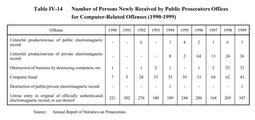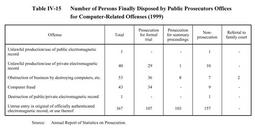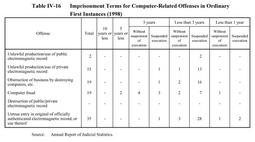| Previous Next Index Image Index Year Selection | |
|
|
1 Trends in computer-related offenses and disposition by public prosecutors offices and courts A revision to the Penal Code in1987created the new offenses of unlawful production and use of electromagnetic records, obstruction of business by destroying computers, etc. , and computer fraud. The aim of this was to provide a proper response to wrongful acts related to the fast-growing field of electronic data processing systems, including computers.
Table IV-14 shows the number of persons newly received by public prosecutors offices in the last ten years for such computer-related offenses. The number for computer fraud topped30in1993and reached43in1999. Table IV-14 Number of Persons Newly Received by Public Prosecutors Offices for Computer-Related Offenses(1990-1999) Table IV-15 shows the composition of final dispositions by public prosecutors offices for computer-related offences in1999. Final dispositions for computer fraud were made for43persons, including prosecution for formal trial for34persons(79.1%)and non-prosecution for9persons(20.9%). No suspects were referred to family courts.Table IV-15 Number of Persons Finally Disposed by Public Prosecutors Offices for Computer-Related Offenses(1999) Table IV-16 shows the terms of sentences pronounced by first instance courts for computer-related offenses in1998. For computer fraud,1person(5.3%)was sentenced to imprisonment with labor for less than one year,9persons(47.4%)for one year or more but less than three years,7persons(36.8%)for three years, and2persons(10.5%)for between three and five years. The suspended sentence rate stood at52.6%.Table IV-16 Imprisonment Terms for Computer-Related Offenses in Ordinary First Instances(1998) |


